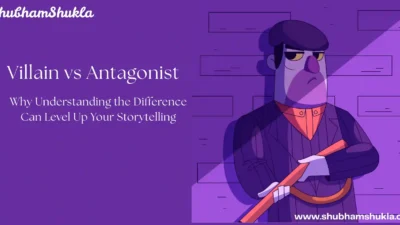Ever finished a novel and felt like you went on an emotional journey with the main character? That’s the magic of a well-crafted character arc not just what happens to the character, but how they change because of it.
- What Exactly Is a Character Arc?
- Why Character Arcs Matter So Much
- The Three Main Types of Character Arcs
- Crafting a Character Arc That Feels Real
- In My Own Experience, I Found That…
- Mistakes to Avoid with Character Arcs
- Character Arc Examples to Learn From
- Let Your Characters Grow — And Take Us With Them
- FAQ: Character Arc Questions
Writers often get wrapped up in worldbuilding or crafting the perfect plot twist, but it’s the internal evolution of a character that sticks with readers long after the last page. That’s why understanding the character arc isn’t just helpful—it’s essential to writing fiction that resonates.
Let’s dig into what makes a great character arc, why it matters, and how you can use it to elevate your stories.
What Exactly Is a Character Arc?
At its core, a character arc is the transformation a character undergoes over the course of a story. This isn’t just about learning a lesson or making a big decision. It’s about the internal shift—in beliefs, values, self-awareness, or identity—that occurs as the character faces challenges.
Think about Frodo in The Lord of the Rings. He starts off as a quiet hobbit from the Shire with no desire for adventure. But by the end? He’s deeply changed, bearing the scars (emotional and physical) of his journey. That’s a textbook positive character arc—he evolves, though not without cost.
But not every arc is about growth. Some characters fall. Think of Walter White in Breaking Bad—a man who goes from sympathetic to monstrous. That’s a negative character arc, and it’s just as powerful when done well.
And sometimes, the character doesn’t change—but instead, changes others. These are flat arcs, like Atticus Finch in To Kill a Mockingbird, who holds to his values in a shifting, flawed world.
You may also like: Best Durjoy Dutta Books: Top 10 Must-Read Love Stories
Why Character Arcs Matter So Much
The character arc is where your story gets its heart. Readers don’t just care about what’s happening—they care about who it’s happening to and how it affects them.
When a reader sees a character struggle and change, it sparks empathy. We reflect on our own beliefs, fears, and growth. A strong arc creates that emotional glue.
Let’s take Katniss from The Hunger Games. She starts out fiercely independent and focused solely on survival. But by the end, she’s a symbol of resistance—still tough, but now aware of her role in something bigger. Her arc gives the story its emotional depth.
Without a compelling character arc, even the most exciting plot can feel empty.
The Three Main Types of Character Arcs
There’s no one-size-fits-all when it comes to character arcs, but most fall into one of three categories:
1. Positive Arc
- The character grows, overcomes inner flaws, and learns a valuable truth.
Example: Elizabeth Bennet in Pride and Prejudice—she learns to see beyond first impressions and pride, embracing vulnerability and love.
2. Negative Arc
- The character declines, either becoming worse or failing to overcome internal struggles.
- Example: Anakin Skywalker in Star Wars—his fear and anger consume him, leading to his transformation into Darth Vader.
3. Flat Arc
- The character stays the same, but their beliefs or strength impact others or the world around them.
- Example: Jon Snow in Game of Thrones (season-dependent)—his arc is less about change and more about staying true to his values in the face of adversity.
Knowing which arc suits your character can help shape the entire emotional rhythm of your story.
You may also read: Real Character Development: 9 Proven Methods To Redefine You
Crafting a Character Arc That Feels Real
So, how do you write a character arc that doesn’t feel forced or cliché? Start by asking: What does my character believe at the beginning? And what will they believe at the end?
Here’s a loose structure to guide you:
- The Lie They Believe: A flawed belief about themselves or the world (e.g., “I’m not worthy of love”).
- The Challenge: The plot throws obstacles that force the character to confront this belief.
- The Turning Point: A moment of crisis that pushes them toward growth—or descent.
- The Truth Revealed: The character sees the truth (or fails to).
- The Resolution: Emotional and thematic payoff. They’ve changed—and we feel it.
Don’t think of this as a rigid formula. It’s more like emotional scaffolding. Let the story breathe within it.
You may also like: Top 10 Names of Demons in the Bible
In My Own Experience, I Found That…
In my own experience, I found that writing a character arc becomes much easier when I stop trying to “engineer” it and instead let the character respond to what’s happening.
One time, I was stuck on a draft for weeks until I realized my protagonist wasn’t changing she was reacting, but not growing.
Once I asked myself, “What is she afraid to admit about herself?” everything clicked. The plot stayed mostly the same, but her emotional journey deepened and suddenly the ending felt earned.Sometimes, the arc isn’t about who the character becomes. It’s about who they stop pretending to be.
Mistakes to Avoid with Character Arcs
Here are a few common pitfalls that can weaken your character arc:
- No transformation: If the character ends the story exactly as they started, readers may feel cheated.
- Unbelievable change: Transformation should feel earned, not sudden or unexplained.
- Passive characters: Make sure your character’s choices, not just events, drive the arc.
- Forcing the arc to fit the plot: Let the emotional journey evolve naturally through believable challenges.
Character Arc Examples to Learn From
Here are a few stellar arcs you can study:
- Samwise Gamgee (LOTR): From loyal gardener to unshakable hero.
- Jamie Lannister (Game of Thrones): His slow redemption, backslide, and ultimate conflict is both tragic and human.
- Eleanor Shellstrop (The Good Place): A selfish grifter learns to care deeply and become a better person. It’s funny, heartfelt, and emotionally rich.
These arcs show us that change doesn’t have to be dramatic. It just has to feel real.
Let Your Characters Grow — And Take Us With Them
At the end of the day, readers don’t return to books for the plot twists. They come back for the people. For the flawed, messy, hopeful characters who remind us of ourselves—or who we want to be.
A great character arc takes us on an emotional ride, where the inner journey matters just as much as the outer one. It doesn’t have to be perfect, but it does have to be honest.
So when you’re building your next character, don’t just ask what happens to them. Ask how it changes them.
FAQ: Character Arc Questions
Q1: Can a story have multiple character arcs?
Absolutely! Secondary characters can have arcs too—just be sure the protagonist’s arc stays central.
Q2: What if my character doesn’t change much?
Then you may be writing a flat arc—and that’s okay! Just ensure their core traits challenge the world around them.
Q3: How do I avoid a cliché arc?
Ground it in real emotion. Make it specific to your character’s background, flaws, and fears.
Q4: Should the character arc match the plot structure?
Ideally, yes. The events of the plot should trigger emotional beats in the arc—it’s all part of the same rhythm.



